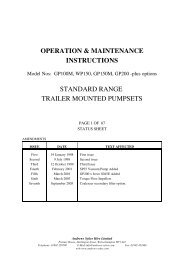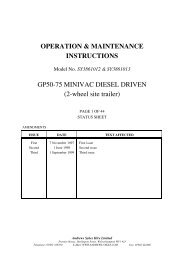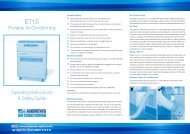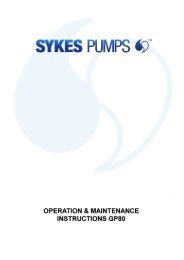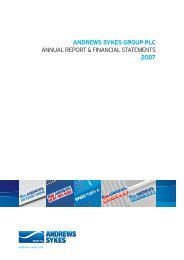Cooling & Heating - Andrews Sykes
Cooling & Heating - Andrews Sykes
Cooling & Heating - Andrews Sykes
You also want an ePaper? Increase the reach of your titles
YUMPU automatically turns print PDFs into web optimized ePapers that Google loves.
Air conditioning basicsWhen the temperature rises, our ability to work suffers and vital equipment candevelop faults. In order to prevent these problems, <strong>Andrews</strong> <strong>Sykes</strong> offer a widerange of temporary, portable air conditioners, with or without air cooled externalheat exchangers.compressorevaporatorcondensorexpansion valveThe basic principle of air conditioningAn air conditioner is a closed refrigerant system, comprising of an evaporator, a compressor,a condenser and an expansion valve (or capillary), which are all connected to each other withrefrigerant piping. Refrigerant gas is circulated within the system in the direction shown in theabove drawing.The indoor unit, which is usually installed in the room to be cooled, contains the process wherethe refrigerant evaporates within the cold element (evaporator). This evaporation is causedbecause the refrigerant has a very low boiling point of -40.8ºC at atmospheric pressure.To enable the evaporation, a rise in temperature is necessary. This rise is supplied by the air ofthe room which is to be cooled and in which the evaporator is situated. As air is passed overthe evaporator the air temperature will drop and therefore enable the room air temperature tobe reduced.The compressor draws the vapour refrigerant and reduces the pressure in the evaporator.Because of this pressure reduction the refrigerant evaporates. The vapour which is drawn bythe compressor is then compressed. The pressure and temperature of the gas rises as it iscompressed into the condenser, where the warm gas is cooled down to the condensationtemperature of the refrigerant. Subsequently the vapour returns back to liquid again. In thecondenser the process is almost directly opposite to the evaporator. The condensor requirescooling otherwise the temperature and gas pressure will rise too high. For this cooling processeither water or air can be used.The vapour which has now returned to liquid again is now passed through the expansionvalve (or capillary) to the evaporator. Because of the narrowing of the pipework the pressuredecreases and the refrigerant evaporates once more. To enable this evaporation the warm air isneeded and so the circuit is closed.12 Click www.andrews-sykes.com





